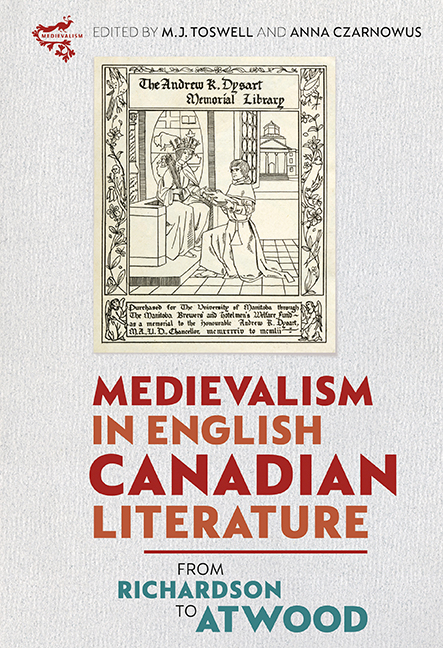Book contents
- Frontmatter
- Contents
- Introduction: English Canadian Medievalism
- 1 “Men of the North”: Archibald Lampman's Use of Incidents in the Lives of Medieval Monarchs and Aristocrats
- 2 “Going Back to the Middle Ages”: Tracing Medievalism in Julia Beckwith Hart's St. Ursula's Convent and John Richardson's Wacousta
- 3 John Richardson's Wacousta and the Transfer of Medievalist Romance
- 4 A Canadian Caliban in King Arthur's Court: Materialist Medievalism and Northern Gothic in William Wilfred Campbell's Mordred
- 5 Orientalist Medievalism in Early Canadian Periodicals
- 6 The Collegiate Gothic: Legitimacy and Inheritance in Robertson Davies's The Rebel Angels
- 7 Earle Birney as Public Poet: a Canadian Chaucer?
- 8 “That's what you get for being food”: Margaret Atwood's Symbolic Cannibalism 129
- 9 Lost in Allegory: Grief and Chivalry in Kit Pearson's A Perfect, Gentle Knight
- 10 Remembering the Romance: Medievalist Romance in Fantasy Fiction by Guy Gavriel Kay and Charles de Lint
- 11 Medievalisms and Romance Traditions in Guy Gavriel Kay's Ysabel
- 12 The Medieval Methods of Patrick DeWitt: Undermajordomo Minor
- Index
- Miscellaneous Endmatter
3 - John Richardson's Wacousta and the Transfer of Medievalist Romance
Published online by Cambridge University Press: 25 March 2020
- Frontmatter
- Contents
- Introduction: English Canadian Medievalism
- 1 “Men of the North”: Archibald Lampman's Use of Incidents in the Lives of Medieval Monarchs and Aristocrats
- 2 “Going Back to the Middle Ages”: Tracing Medievalism in Julia Beckwith Hart's St. Ursula's Convent and John Richardson's Wacousta
- 3 John Richardson's Wacousta and the Transfer of Medievalist Romance
- 4 A Canadian Caliban in King Arthur's Court: Materialist Medievalism and Northern Gothic in William Wilfred Campbell's Mordred
- 5 Orientalist Medievalism in Early Canadian Periodicals
- 6 The Collegiate Gothic: Legitimacy and Inheritance in Robertson Davies's The Rebel Angels
- 7 Earle Birney as Public Poet: a Canadian Chaucer?
- 8 “That's what you get for being food”: Margaret Atwood's Symbolic Cannibalism 129
- 9 Lost in Allegory: Grief and Chivalry in Kit Pearson's A Perfect, Gentle Knight
- 10 Remembering the Romance: Medievalist Romance in Fantasy Fiction by Guy Gavriel Kay and Charles de Lint
- 11 Medievalisms and Romance Traditions in Guy Gavriel Kay's Ysabel
- 12 The Medieval Methods of Patrick DeWitt: Undermajordomo Minor
- Index
- Miscellaneous Endmatter
Summary
MEDIEVALIST ROMANCE IN Canada did not appear out of nowhere. Its presence in early Canadian literature was firmly grounded in the situation in which, to quote from Kathryn Brush's introduction to Mapping Medievalism at the Canadian Frontier, “the Middle Ages [were] embedded in Canadian history, identity, and culture in the form of mental conditioning.” In architecture, Gothic/Medieval Revival buildings were erected, including, for example, the London District Courthouse built between 1827 and 1829. Gothic conventions started to be used in literary texts, including novels such as John Richardson's Wacousta, in which the Gothic conventions acquired a medievalist element. In this novel the literary medievalism is complemented with medievalist buildings, starting with Fort Détroit and ending with the medieval and post-medieval castles of Scotland and Cornwall. More specifically, the literary tradition of romance writing was transferred to Canada in a manner very similar to the transfer of Gothic architecture to the British colony. Furthermore, the indigenous past could provide white settlers with an equivalent of the medieval European past.
Richardson's classic Wacousta, published in 1832, exemplifies both the cultural transfer of gothicisms to Upper Canada and the transmission of romance as a genre from the Middle Ages to the eighteenth and early nineteenth century, where it often adopts the form of colonial romance. The novel demonstrates the two manners in which the Middle Ages existed in the Enlightenment, which was apparently continued in Romanticism, at least in Canada. John Simons comments on this two-faceted presence of the medieval in this cultural period in England as the vogue for the Gothic, understood as the fanciful “Strawberry Hill” Gothic of Horace Walpole and his imitators.3 On the one hand the Middle Ages were imagined as the time of barbarism and viciousness, and on the other, as Simons argues:
the Gothic romances of Walpole, Radcliffe, Reeve and others exploited this very distaste and made it a subject for fiction. Contrary to the current critical orthodoxy on Gothic fiction, which tends to offer to an otherwise repressed audience a titillating and almost pornographic alternative to mainstream literature and representing a revolutionary new direction in taste, careful reading of the romances will disclose that the Gothic actually reproduced very faithfully a body of opinion about the Middle Ages that had been current in one form or another for the best part of half a century.
- Type
- Chapter
- Information
- Medievalism in English Canadian LiteratureFrom Richardson to Atwood, pp. 52 - 65Publisher: Boydell & BrewerPrint publication year: 2020



